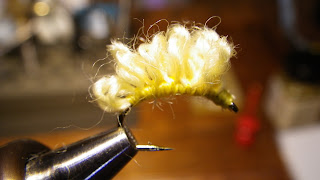Sunday, January 6, 2013
The original and sadly forgotten sucker spawn fly pattern
The sucker spawn is a fly pattern well known to steelhead anglers. It's tied in a myriad of colors and materials, including one variation called "the crystal meth" that uses diamond braid. BTW, I am getting rather perturbed by the new trend in fly patterns that seems to require obscene or coarse names for otherwise beautiful flies. But enough of that.
The sucker spawn is well known to anyone who fishes steelhead, especially those who fish steelhead alley in Ohio. For those of you who do not know about this, ODNR manages many Lake Erie tributaries for steelhead. Smolts are stocked in the rivers, and they emigrate to Lake Erie's cold eastern basin for a year or two, then return to spawn. To my knowledge there is no natural spawning, but fish hang in the rivers much of the winter and they eat flies well, probably because there isn't that much natural insect life compared to their native habitats. The Erie tribs have a reputation for producing double digit numbers of smallish fish (2-5 lb) but every time I fish there I get my clock cleaned by a Chinook-sized steelhead at least once per day.
The sucker spawn is a consistent producer because, lo and behold, it looks like a skein of sucker eggs! But if you ask most people they view it as a modern steelhead pattern that originated in the midwest. Not true, it was a trout fly that came from Pennsylvania and was in use by the 1970's. I became acquainted with it in 1973 when a childhood friend took me fishing on the flies-only stretch of the Tulpehocken River in Berks County, PA. It was the trout opener. He gave me two flies, and we caught so many fish that several gentlemen demanded to see our terminal rigs to verify that we were not using bait. Now, these were stocked trout, but I have used the pattern off and on in other trout streams with great success over the years.
I had wondered about the origins of the pattern for years, but recently Lefty Kreh mentioned that he was shown the pattern in Pennsylvania about 40 years ago (an online article about six flies to carry at all times). And he mentioned the original color (cream) which is consistent with what I was given. So the pattern really started as a trout fly in eastern PA, and only later became a steelhead fly. Here is the recipe and tying instructions:
Materials: two pieces of cream colored wool yarn about 5 inches long. Tying thread. The original used white or cream. The example in the photo is yellow Danville flat waxed nylon. I have no idea what the wool was but it was pretty coarse. Makes for a rough looking fly, but who cares? The fish eat it. I like a big meaty size ten, Lefty Kreh mentions sizes 12-16 as his preferred hook sizes.
Instructions: Cover the hook shank with thread. If using a modern curved shank hook, bring the thread well back. Tie in two pieces of yarn. Form small loops with both, lash down with two wraps, then secure with two wraps right in front of the loops you just created. Keep marching up the hook shank with double loops until you reach the eye, then whip finish. The secret is to use two pieces of yarn which makes the tying go fast and easy. I don't think that the yarn material matters, but color does. I still prefer cream after all these years, although blaze orange (Bernat acrylic yarn color 00615) is a killer on steelhead. The acrylics do give you neater loops as well and you can also use teased out egg yarn. . Always have a couple of cream sucker spawns somewhere in the box. I like them best on misty days when the water has a slight stain.
Subscribe to:
Post Comments (Atom)


Thanks you lot for providing very spectacular possibility to read from this site,great work.thanks for sharing. Effective language use in the Blog..i realy like to read ur blog...Nice
ReplyDeletecheck over here
Next page
Original info
Main page